|
Exhibition at Suigyoku Gallery
February 3rd to 9th, 2002
2-45-11, Itabashi, Itabashi-ku, Tokyo
Tel 03-3961-8984
The World of Alluring White Porcelain
Bringing Out the Smoothness and Glamour
of White Porcelain Clay to Its Utmost Limit
Interview and Text by Yokoya Hideko
Translated by Keiko Nishi
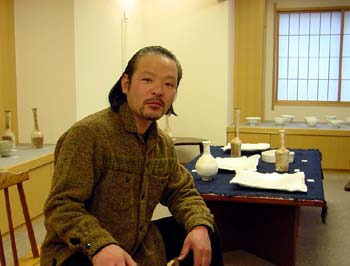
Introduction by Interviewer
In front of me is a World of White. This is the glamorous world of Kato Tsubusa, a potter devoted to white porcelain clay. When one rivets the eyes on Kato's shapes, which look pure at a glance, they will be drawn into the smooth white porcelain skin, into the sensual curvy lines that cannot be created by calculation, and into the delicate color tone weaved by the glazes. It is almost as if the works were beckoning saying "Come on, come here." Most porcelain is fired in a gas-fired kiln; the works presented at this exhibition were fired in Kato's wood-fired kiln at Kawakomaki in Kamo-gun, Gifu. That is why the word "Kawakomaki" is in the name of all the pieces.
INTERVIEW
Snow White, Bluish White, Ivory
(Q=Question from Interviewer, A=Answer from Artist)
Q: Although it is generally called "white porcelain," there are varieties of white such as snow white, bluish white, ivory, etc. How do you create the variations?
A. It is not what I create, rather variations come out like this because of the use of the wood-fired kiln. Every piece gets fired evenly in a gas-fired kiln, but in a wood-fired kiln some pieces are fired a lot while others are not. Flames and winds always vary. Plus all the burned ash, sand, and dust stick to pieces. Those accidents create subtle changes on the pieces. Where the flame is full of life, glaze rolls on the piece swiftly, while the pieces turn out dull where there is not much flame. It depends how the flame runs.
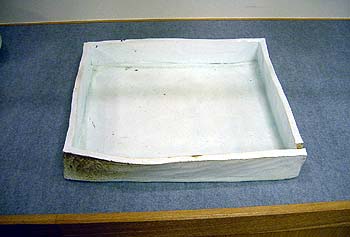
Kawakomaki White Porcelain Kiritachi - Big Square Bowl
The brownish area is a landscape created by fused ash and dust
Q: The white surface sometimes turns yellowish or transparent cobalt blue. Is it the glaze?
A. Yes. I use a transparent glaze. But ash falls in a wood-fired kiln, and the glaze gets mixed with the ash. As a result, it turns bluish, greenish, or yellowish. Also, this blue is different from the blue white porcelain fired accurately in a gas-fired kiln. I use exactly the same transparent glaze, but the color results vary by the way they are fired.
|

|
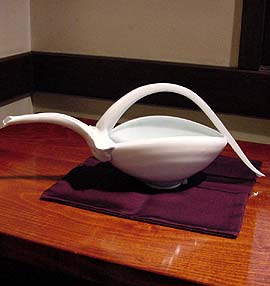
|
|
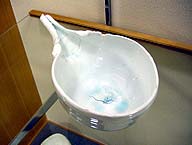
|
|
Kawakomaki White Porcelain Katakuchi; please see the beautiful blue in its depth.
|
|
|
Bluish White Porcelain Choshi. This piece was fired in a gas-fired kiln. Please compare its color tone with the one fired in a wood-fired kiln.
|
|
|
Using Difficult Clay Efficiently:
Porcelain Clay from New Zealand
Q: Do you use clay from Amakusa for your porcelain like Arita-yaki?
A. My clay comes from New Zealand. The principal ingredient is New Zealand kaolin, and some other elements are added in order to make it sticky. Because New Zealand clay is used for industrial products, there are many factories processing the clay in Tajimi, Toki, and Mizunami where I am from. I buy a ton or two of the clay and use it after mixing it using a clay mixer.
Q: How easy is it to handle?
A. There are certain kinds of clay that are easy to handle while some are hard to handle. But the clay from New Zealand is difficult to shape, extremely difficult. It hardly grows taller when it is turned on a wheel. If one who is not used to the clay he uses, he gets surprised. I was very shocked by it too. About 20 years ago I used to deal with stoneware, like red clay, and was not working with porcelain clay. However, one day I came across upon this porcelain clay and have since become devoted to it.
Q: What made you want to work with clay that was so hard to handle?
A. I was confident of my technique on a wheel, but it was totally destroyed. (laughs) It was so hard to handle that I was about to give up. But if I had given up, I would have felt like I lost to myself. In addition to that, the clay was so amazingly white and that attracted me. Porcelain clay from Amakusa is ivory-toned, but the clay from New Zealand is snow white.
|
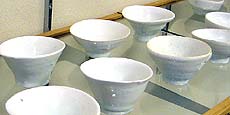
|
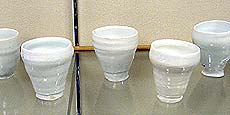
|
|
Kawakomaki White Porcelain Guinomi
|
Kawakomaki White Porcelain Yunomi
|
|
Q: You are famous for snow white objects. They are very delicate and complicated in shape. I wonder how you made such things using that difficult clay.
A. (laughs) Yes, they came after many trials and errors. I had not planned to make those shapes, but when I was creating something and focusing on bringing out the porcelain clay's smoothness and glamour, it turned out to be those shapes.
Q: I see some stoneware works besides white porcelain pieces at this exhibition.
A. The clay was from a mountain in Tajimi, my hometown and also from construction sites.
Q: What? Construction sites?
A. When they scrape a mountain to cut a road, the clay is left at the exposed areas. When the workers are off, like Sundays, I cross over the fence, dig some clay up, and put it in a bag.
Q: For free?
A. Generally no one asks for money, ha ha ha! Places like Tajimi or Seto where there is more than 1000 years of pottery history are all like that. Clay is just like water or air. (laughs)
Q: Oh, the feeling of a pottery center is like that?
A. Yes, just like that. (laughs) There are stopes for clay to make industrial products, but a layer of sticky clay happens to come out. The color and stickiness vary depending on the layer of earth. Seeing the different characteristics of clay is interesting. In some cases, without digging deeply, the surface of a mountain reveals sticky clay. The mountain itself is a sticky clay mountain.
Addicted to Clay
Q: I heard you were born in Tajimi City. Is your family in a pottery related business?
A. Yes. I grew up in such circumstances. Some relatives of mine had a pottery factory. So my parents helped them and I had many opportunities to deal with clay. I think my grandfather influenced me a lot, too. He was not a potter, but he made figurines of alligators or tigers. When I was a child, I made a monster and something else just like playing with a toy. You know, children play with blocks at nursery school. The clay was always around me just like that. I was not especially trained to be a potter when I was little.
Q: So when did you make up your mind to be a potter?
A. Well, it was when I was in middle school, I think. I hated school, anyway. (laughs) I rather liked to go to a mountain and dig a hole to make a fort.
Q: Sounds fun!
A. What I am doing now might not be so different from that. (laughs) Our playground was a stope for clay. Now it is forbidden to enter to prevent accidents. It was open in my time. My friends and I threw clay at each other and were covered with mud from head to foot. (laughs)
Q: Clay is almost like a part of your body, then.
A. Yeah, it is. I'm addicted to clay. I am almost addicted to sticky clay. (laughs) When I don't touch clay for a while, I begin missing it. And when I make something of clay after a while, I feel myself again. I assume all potters will agree with me. Clay is everything.
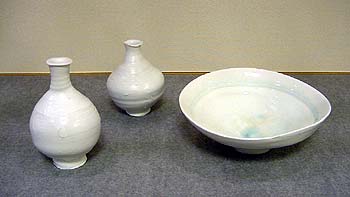
Kawakomaki White Porcelain Shallow Bowl
and Kawakomaki White Porcelain Tokkuri
The Time of Being an Apprentice
Things that Set the Stage for Myself
Q: You studied at Tajimi City Ceramic Design Institute, didn't you?
A. Yes. Now it has became so popular among young people that it is hard to get in. The institute was established originally to train young people to support local industries, not to train potters. Therefore, in my time we were not allowed to work on the wheel much. It rather focused on "design," the training of "creating an image for molding," such as creating a plaster mold as a prototype for mass production.
|
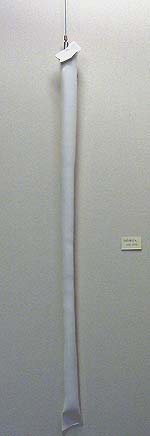
|
|
Kawakomaki White
Porcelain Kake-Hanaire
90 cm in length
|
|
|
Q: But what you learned there was beneficial?
A. It was absolutely beneficial. It helped me a lot because I was introduced to information of not only designs of chawan and plates that were everywhere in Tajimi, but also designs of ceramics and furniture from all over the world. If I had only seen Tajimi, I would only know typical designs like a karako pattern (Chinese motif of children) on chawan, for instance. I could have been a person who does not know much of the world, but I was exposed to designs from New York or Italy. It was pretty shocking.
Q: Your work's somewhat contemporary atmosphere might come from that influence. Did you have a job of drawing on pottery at a local kiln temporary after that?
A. Yes. I got a job at a kiln. I was only allowed to mix clay in a clay mixer, or to attach a handle to the body of a coffee cup made using a mold. The person next to me was skillful and drew on a pot in such a cool manner. I was jealous! (laughs) but I was attaching a handle one after another and another. I became fed up with the sequency. While I was thinking I did not come to do such job, I did my best. I wanted to earn pocket money, so it could not be helped. One day, one of the drawing people left, and they were looking for a young person to replace him.
Q: "I'll do it!," you said?
A. It was not such a big thing to ask for -- five workers, four girls and I, were going to be tested how well we could draw. The theme was a weed - having a stem standing straight with small dot-like red flowers on top with a thin long leave, called mizuhiki, which was often used as a flower for the Japanese tea ceremony. The result was that I was the worst (laughs), but they chose me for my vigorous brushstrokes. I drew with full energy. It is important to be vigorous when one draws on an unglazed pot.
Q: You did it!
A. Yes, but I was drawing mizuhiki day after day and got tired of it. Yet, I was allowed to draw some other patterns too little by little. But, until I finally left there, I was told that I was such a dub. For example, the chicks I drew on coffee cups. Those chicks had to be drawn precisely the same, but each of them varied in my case, some elongated and some chubby. No stability at all.
Q: You don't like to do what you are told to?
A. No, I don't. There was a design just with dots, but it was too much of a bother for me to draw dots. When I had to draw six dots evenly by the yunomi's lip edge, I just drew five. (laughs) But no one noticed. When I visited the kiln a while after I had left, the rest of people were drawing five dots, too.
Q: So, that became entrenched. (laughs)
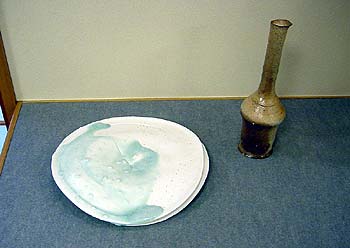
Kawakomaki Unglazed Porcelain Hanaire
and Kawakomaki Ash-Glazed Large Plate
A. Even after that, I made 500 yunomi and then 1000 yunomi on a wheel as a part-time job. Through the experience, I was trained by the local industry. I can not make stuff like standard products now, but I know that my skill is based on the experience.
Q: So your unconventional work was born on that firmly established foundation. What kind of work would you like to make in future?
A. I would like to work both on porcelain and stoneware, but especially more and more doing various designs with porcelain.
Q: Did you get fed up with drawing on a pot? (laughs)
A. Nope, I will continue drawing! It is nothing, but just vigor. (laughs) Indeed, just a little while ago, a visitor who saw my work asked me, "Did you just drip blue paint?" I answered: "No, not at all. I draw it decently. It is in fact a picture." (laughs)

Kawakomaki Sometsuke rectangular plate
An impressive large plate with a beautiful deep blue
Kato Tsubusa Biography
- Born in Onada City, Tajimi in 1962
- Graduated from the Tajimi City Ceramic Design Institute
- Built a kiln in Tomika-cho in 1984
- Exhibited works at Asahi Pottery Exhibition in 1984
- Exhibited works at Chunichi International Pottery Exhibition, Clay-Message in Mino Division, 1987
- Exhibited works at Beauty of Modern Pottery, 'Rin,' at The Shigaraki Ceramic Cultural Park in 1996
- Exhibited works at New Expression in Porcelain: Developments in the 1990s at The National Museum of Modern Art, Tokyo in 1996
- Exhibited works at Contemporary Molding of Pottery Exhibition at Rias Ark Museum of Art, Kesennuma in 1998
- One-person exhibitions all over Japan
Other Pieces by Kato Tsubusa
|